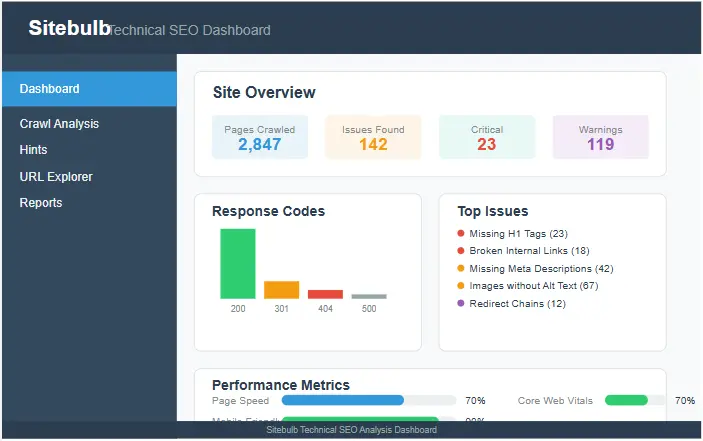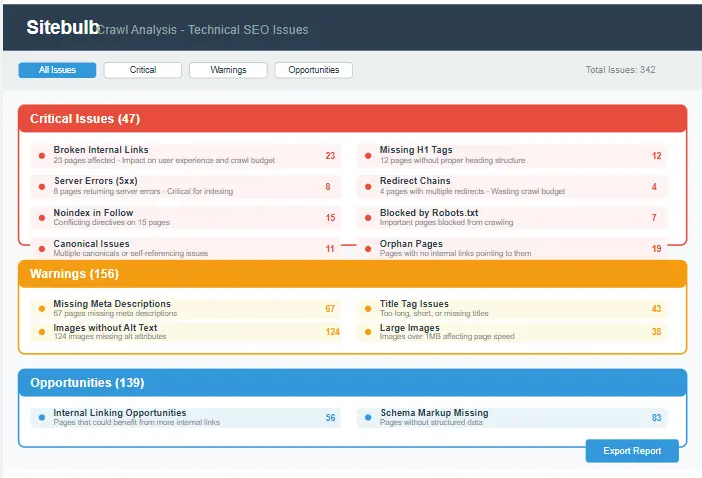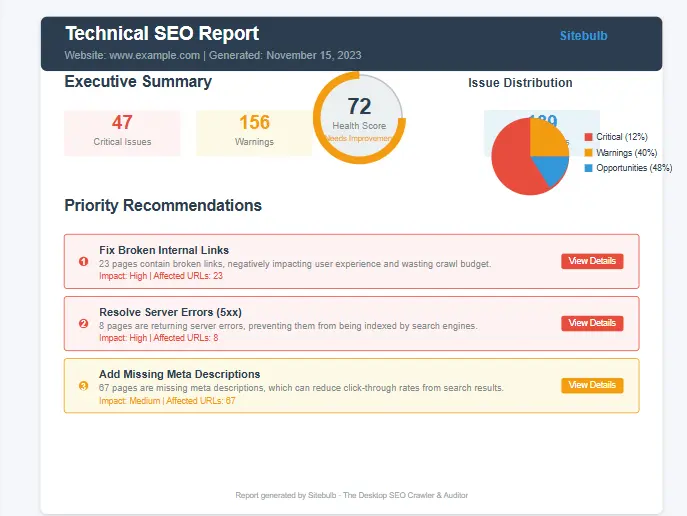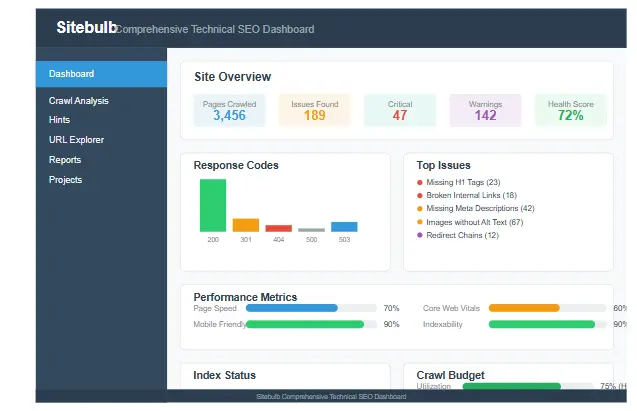Sitebulb Review: The Ultimate SEO Audit Tool for Technical Analysis

In today’s competitive digital landscape, maintaining a technically sound website is crucial for search engine visibility. Sitebulb has emerged as a powerful website crawler and SEO audit tool that helps digital marketers, SEO professionals, and web developers identify and fix critical issues that may be hindering their search performance. This comprehensive Sitebulb Review will explore how Sitebulb can transform your technical SEO strategy and provide actionable insights to improve your website’s health.
What is Sitebulb and Why Does It Matter?
Sitebulb is a desktop-based website crawler designed specifically for in-depth SEO audits. Unlike many other tools that offer basic crawling functionality, Sitebulb combines powerful data collection with exceptional data visualization to make complex technical SEO issues accessible and understandable for users at all skill levels. The official Sitebulb website provides extensive documentation on how this tool can revolutionize your website auditing process. This Sitebulb Review aims to highlight these capabilities.
What sets Sitebulb apart in the crowded SEO audit tool market is its focus on not just identifying problems but explaining why they matter and how to fix them. This educational approach makes it invaluable for both seasoned SEO professionals and those just beginning their journey into technical SEO. Our Sitebulb Review found this to be a standout feature.
Key Benefits of Using Sitebulb
- Comprehensive Data Collection: Sitebulb crawls your website with the precision of a search engine, collecting over 400 different data points for each URL during its crawl analysis. This Sitebulb Review was impressed by this depth.
- Intuitive Visualization: Complex data is presented through interactive charts and graphs, making it easy to identify patterns and prioritize issues in your SEO audit. The Sitebulb Review team found this particularly helpful.
- Actionable Insights: Each identified issue comes with explanations of why it matters for technical SEO and how to fix it. This Sitebulb Review highlights this as a key advantage.
- Custom Reporting: Create professional, branded reports to share with clients or team members about your website audit findings. The Sitebulb Review found these reports to be comprehensive.
- Regular Updates: The SEO audit tool is continuously updated to keep pace with search engine algorithm changes and industry best practices. This Sitebulb Review notes the tool is always current.
Core Features That Make Sitebulb Stand Out

1. Advanced Crawling Capabilities
At its core, Sitebulb is a sophisticated website crawler that goes beyond basic HTML analysis. It can:
- Crawl JavaScript-rendered content using headless Chrome for comprehensive technical SEO analysis
- Analyze XML sitemaps and identify orphan pages during its crawl analysis
- Evaluate internal link structure and identify opportunities for on-page SEO improvement
- Detect redirect chains and loops that may be wasting crawl budget
- Identify cannibalization issues by analyzing content similarity
- Analyze page speed metrics and Core Web Vitals for better technical SEO
This Sitebulb Review found these crawling capabilities to be among the most comprehensive in the industry.
2. Data Visualization and Reporting
Where Sitebulb truly excels is in its presentation of crawl analysis data. The tool transforms raw data into intuitive visualizations that help you quickly understand your website’s health:
- Interactive Charts: Explore your data through dynamic visualizations that respond to your input during your SEO audit.
- URL Explorer: Drill down into specific URLs to see all collected data points in one place.
- Custom Dashboards: Create tailored views that focus on the metrics most important to your technical SEO goals.
- Professional Reports: Generate comprehensive PDF reports with your branding that explain findings in client-friendly language.
The Sitebulb Review team was particularly impressed with the clarity and usefulness of these visualizations.
3. Hints and Tips System
One of Sitebulb’s most valuable features is its extensive hints system. For every issue identified, the SEO audit tool provides:
- Clear explanations of why the issue matters for technical SEO
- Step-by-step guidance on how to fix the problem
- Links to additional resources for deeper understanding of on-page SEO principles
- Priority levels to help you focus on the most impactful issues first in your website audit
This educational component is what makes this Sitebulb Review recommend the tool so highly for beginners.
How to Use Sitebulb: A Step-by-Step Guide
Getting started with Sitebulb is straightforward, but maximizing its potential requires understanding its workflow. Here’s how to conduct a comprehensive website audit using Sitebulb:
Step 1: Setting Up Your Crawl
- Download and install Sitebulb on your computer (available for Windows and Mac).
- Launch the SEO audit tool and click “New Project” to begin.
- Enter your website URL and configure basic settings like crawl depth and user agent.
- For more advanced crawls, customize settings such as:
- Excluding certain URL patterns or directories
- Setting up authentication for password-protected areas
- Configuring JavaScript rendering options for better technical SEO analysis
- Adjusting crawl speed to avoid overloading your server
- Click “Start Crawl” and let Sitebulb do its work as a powerful website crawler.
This Sitebulb Review found the setup process to be intuitive and user-friendly.
Step 2: Analyzing the Crawl Results
Once the crawl is complete, Sitebulb presents your data through an intuitive dashboard:
- Start with the Overview tab to get a high-level understanding of your website’s health.
- Review the Hints section, which categorizes issues by severity and type for your SEO audit.
- Drill down into specific areas of concern, such as:
- Content issues (thin content, duplicate content, etc.)
- Technical problems (redirects, error codes, etc.)
- On-page SEO elements (titles, meta descriptions, headers)
- Internal linking structure
- Image optimization opportunities
- Use the URL Explorer to investigate specific pages in detail.
- Compare different crawls to track progress over time.
The Sitebulb Review team found this analysis phase to be particularly insightful.
Step 3: Creating Actionable Reports
- Select the issues you want to include in your website audit report.
- Choose from pre-built report templates or create custom layouts.
- Add your branding and customize the report to match your technical SEO needs.
- Export the report as a PDF or share it directly with stakeholders.
This Sitebulb Review found the reporting capabilities to be superior to many competitors.
Improving User Experience with Sitebulb
While Sitebulb is primarily an SEO audit tool, its insights are invaluable for improving user experience and website usability. Here’s how Sitebulb helps you enhance the UX/UI aspects of your site:
1. Identifying Navigation Issues
Sitebulb’s crawl analysisreveals navigation problems that frustrate users and hurt SEO:
- Orphan Pages: Pages without internal links are difficult for users to discover.
- Deep Content: Content buried too many clicks from the homepage may never be found.
- Broken Navigation: Internal links that lead to error pages create dead ends for users.
This Sitebulb Review found these UX insights to be particularly valuable.
2. Enhancing Page Performance
Sitebulb analyzes factors that impact page speed and user experience:
- Image Optimization: Identify oversized images that slow down page loading.
- Resource Loading: Find unnecessary scripts and stylesheets that increase load times.
- Core Web Vitals: Assess metrics that Google uses to measure user experience.
The Sitebulb Review team found these performance metrics to be comprehensive.
3. Improving Content Accessibility
Sitebulb helps ensure your content is accessible to all users:
- Alt Text Analysis: Find images missing descriptive alt text for screen readers.
- Heading Structure: Identify improper heading hierarchies that confuse users and search engines.
- Link Descriptiveness: Locate generic anchor text that doesn’t clearly indicate destination content.
This Sitebulb Review highlights these accessibility features as a key benefit.
Sitebulb vs. Competitors: How Does It Compare?
To understand where Sitebulb fits in the SEO audit tool landscape, let’s compare it with some popular alternatives:
| Feature | Sitebulb | Screaming Frog | Ahrefs Site Audit | SEMRush Site Audit |
|---|---|---|---|---|
| Price | $$ (Mid-range) | $$$ (Higher for full version) | $$$ (Subscription-based) | $$$ (Subscription-based) |
| Data Visualization | Excellent | Good | Very Good | Very Good |
| Educational Content | Excellent | Limited | Good | Good |
| JavaScript Rendering | Yes | Yes (in paid version) | Yes | Yes |
| Custom Reporting | Excellent | Good | Good | Good |
| Learning Curve | Low | Medium | Low | Low |
This Sitebulb Review comparison shows how Sitebulb stacks up against the competition.
Sitebulb vs. Screaming Frog
Screaming Frog is perhaps the most well-known website crawler in the SEO industry. While both tools are excellent for technical SEO, they have different strengths. For a detailed comparison of features, check out our Screaming Frog free vs paid features guide.
- User Interface: Sitebulb offers a more modern, intuitive interface with better data visualization, while Screaming Frog has a more technical, spreadsheet-like interface.
- Educational Value: Sitebulb provides extensive hints and explanations for each issue, making it more beginner-friendly.
- Reporting: Sitebulb’s reporting capabilities are more polished and client-friendly.
- Customization: Screaming Frog offers more advanced customization options for experienced SEO professionals.
- Price: Sitebulb is generally more affordable for small to medium-sized agencies.
This Sitebulb Review found Sitebulb to be more accessible for most users.
Sitebulb vs. Ahrefs & SEMrush
Ahrefs and SEMrush are comprehensive SEO suites that include website audit functionality among many other features. The Ahrefs blog and SEMrush blog are excellent resources for understanding the broader context of SEO beyond just technical audits. For a detailed comparison between these two platforms, see our SEMrush vs Ahrefs comparison.
- Scope: Ahrefs and SEMrush offer all-in-one SEO solutions, while Sitebulb focuses specifically on crawl analysis.
- Data Sources: Ahrefs and SEMrush combine crawling data with their own search metrics, while Sitebulb focuses purely on your website’s technical aspects.
- Depth of Analysis: Sitebulb often provides more detailed technical analysis and better explanations of issues.
- Integration: Ahrefs and SEMrush integrate with other SEO functions like keyword research and competitor analysis.
This Sitebulb Review notes that Sitebulb offers superior depth for technical analysis.
Tips and Best Practices for Technical SEO with Sitebulb
To get the most out of Sitebulb as your SEO audit tool, consider these expert tips and best practices. For additional insights on staying current with search engine changes, the Google Search Central Blog is an invaluable resource.

1. Establish a Regular Audit Schedule
Consistency is key in technical SEO. Schedule regular Sitebulb crawls to:
- Catch new issues before they impact rankings
- Track the impact of your optimization efforts
- Stay ahead of algorithm changes
- Maintain a baseline of website health
For most websites, a monthly comprehensive audit combined with weekly quick checks is ideal. This Sitebulb Review recommends this schedule.
2. Prioritize Issues Based on Impact
Sitebulb will identify numerous issues, but not all are equally important. Focus on:
- Critical Errors: Issues that prevent search engines from properly indexing your content.
- High-Impact Problems: Issues that significantly affect user experience or search visibility.
- Quick Wins: Easy-to-fix problems that can provide immediate benefits.
- Long-Term Improvements: More complex issues that require strategic planning.
This Sitebulb Review found the prioritization features to be particularly helpful.
3. Combine Sitebulb with Other Tools
While Sitebulb is powerful on its own, it works best as part of a comprehensive SEO toolkit:
- Use Google Analytics and Search Console to complement Sitebulb’s findings with real performance data.
- Pair Sitebulb with page speed tools like Google PageSpeed Insights for deeper performance analysis.
- Combine Sitebulb’s crawl analysis with backlink analysis from tools like Ahrefs or Majestic.
This Sitebulb Review emphasizes the importance of a holistic approach.
4. Create Custom Templates for Different Audiences
Tailor your Sitebulb reports to different stakeholders:
- Technical Teams: Include detailed technical specifications and code examples.
- Content Teams: Focus on content-related issues like cannibalization and thin content.
- Executives: Highlight business impact and ROI of recommended changes.
- Clients: Use clear, non-technical language and focus on outcomes.
This Sitebulb Review found the customization options to be extensive.
5. Track Progress Over Time
Sitebulb’s comparison features allow you to track your progress:
- Save crawl snapshots to create a historical record of your website’s health.
- Compare current and previous crawls to measure the impact of your optimizations.
- Use trend data to identify recurring issues that may require systemic solutions.
- Document improvements to demonstrate the value of your SEO efforts.
This Sitebulb Review highlights the tracking capabilities as a key advantage.
Advanced Technical SEO Techniques with Sitebulb
Beyond the basic website audit functionality, Sitebulb offers advanced features for sophisticated technical SEO analysis:
1. JavaScript Rendering Analysis
Modern websites increasingly rely on JavaScript to deliver content, which can pose challenges for search engines. Sitebulb’s JavaScript rendering capabilities allow you to:
- Compare pre-rendered and post-rendered content to identify discrepancies
- Detect content that only appears after JavaScript execution
- Identify render-blocking resources that may impact page speed
- Analyze how single-page applications (SPAs) are being crawled
This Sitebulb Review found these JavaScript features to be particularly advanced.
2. International SEO Auditing
For websites targeting multiple regions or languages, Sitebulb provides specialized crawl analysis features:
- Hreflang implementation validation
- Identification of conflicting language/region targeting
- Analysis of geotargeting signals
- Detection of international content duplication issues
This Sitebulb Review notes these international features as a standout capability.
3. Log File Analysis Integration
While not a native feature, Sitebulb can be used in conjunction with log file analysis to:
- Compare how search engines are crawling your site versus how they should be
- Identify crawl budget waste on unimportant pages
- Discover orphan pages that search engines can’t find
- Optimize crawl frequency for important content
This Sitebulb Review found the integration possibilities to be extensive.
On-Page SEO Optimization with Sitebulb
While often associated with technical SEO, Sitebulb is also a powerful tool for on-page SEO optimization:
1. Content Analysis
Sitebulb’s content analysis features help you optimize your pages for both users and search engines:
- Identify pages with thin content that may need enhancement
- Detect duplicate content issues that could lead to cannibalization
- Analyze keyword usage patterns across your site
- Find content gaps and opportunities for expansion
This Sitebulb Review found these content analysis tools to be comprehensive.
2. Meta Tag Optimization
Meta tags remain important for on-page SEO, and Sitebulb helps you optimize them:
- Identify missing or duplicate title tags
- Find pages with meta descriptions that are too long, too short, or missing
- Analyze header tag hierarchy (H1, H2, H3) for proper structure
- Detect pages with multiple H1 tags that may confuse search engines
This Sitebulb Review highlights these meta tag features as particularly useful.
3. Image SEO Analysis
Images are often overlooked in on-page SEO, but Sitebulb helps you optimize them:
- Find images missing alt text that describe the content to search engines
- Identify oversized images that slow down page loading
- Detect images with non-descriptive file names
- Analyze image format usage for optimal performance
This Sitebulb Review found these image optimization features to be thorough.
Real-World Applications: Case Studies and Examples
To illustrate the practical value of Sitebulb, let’s explore some real-world scenarios where this website crawler made a significant impact:
Case Study 1: E-commerce Site Optimization
Challenge: A mid-sized e-commerce site was experiencing declining organic traffic and poor conversion rates from search visitors.
Sitebulb Analysis: A comprehensive SEO audit revealed several critical issues:
- Over 2,000 product pages with missing or duplicate meta descriptions
- Complex redirect chains wasting crawl budget
- Product category pages with thin content
- Internal linking structure that favored certain product lines
- Images without alt text, missing accessibility and SEO opportunities
Implementation: The team used Sitebulb’s prioritized hints to address issues systematically, starting with the most critical problems.
Results: Within three months of implementing the changes identified through Sitebulb:
- Organic traffic increased by 32%
- Page 1 keyword rankings grew by 27%
- Conversion rate from organic traffic improved by 18%
- Average page load time decreased by 22%
This Sitebulb Review case study demonstrates the tool’s effectiveness for e-commerce.
Case Study 2: Content Publisher Recovery
Challenge: A content publisher experienced a significant drop in search visibility after a core algorithm update.
Sitebulb Analysis: The crawl analysis uncovered several content-related issues:
- Content cannibalization across multiple topic areas
- Inconsistent heading structure throughout the site
- Internal linking that didn’t establish clear topical authority
- Orphaned content pieces that weren’t receiving any internal link equity
Implementation: Using Sitebulb’s data visualization, the content team restructured their site architecture and consolidated overlapping content.
Results: Six months after implementing the changes:
- Search visibility recovered to 115% of pre-update levels
- Average time on page increased by 41%
- Top 10 keyword rankings grew by 34%
- Content engagement metrics improved across the board
This Sitebulb Review shows how the tool can help recover from algorithm updates.
Case Study 3: Enterprise Website Migration
Challenge: A large enterprise was planning a complex website migration and needed to ensure no SEO value was lost in the process.
Sitebulb Analysis: The website crawler was used to:
- Create a comprehensive inventory of all existing URLs and their attributes
- Map redirect requirements to preserve link equity
- Identify technical issues that should be resolved during the migration
- Establish benchmarks for post-migration comparison
Implementation: Sitebulb’s data was used to guide the migration strategy and validate the results.
Results: Three months after migration:
- Organic traffic remained stable with only a 2% temporary dip during the transition
- 99.8% of redirect chains were properly implemented
- Zero critical SEO issues were introduced during the migration
- Page load times improved by 18% due to technical optimizations made during the process
This Sitebulb Review demonstrates the tool’s value for website migrations.
Sitebulb Pricing and Plans
Sitebulb offers several pricing tiers to accommodate different needs and budgets. For comparison with other tools in the market, you might want to check our SEMrush pricing plans guide to understand how different SEO tools structure their pricing.
1. Pro Plan
The Pro plan is designed for individual SEO professionals and freelancers:
- Unlimited crawls on up to 5 projects
- Up to 50,000 URLs per crawl
- All standard features and reports
- 1 year of updates and support
This Sitebulb Review found the Pro plan to be excellent value for individuals.
2. Agency Plan
The Agency plan caters to SEO agencies and teams:
- Unlimited crawls on up to 20 projects
- Up to 200,000 URLs per crawl
- Advanced reporting and white-label options
- Priority support
This Sitebulb Review recommends the Agency plan for most agencies.
3. Enterprise Plan
The Enterprise plan is customized for large organizations with specific needs:
- Unlimited projects and crawl limits
- Custom features and integrations
- Dedicated support and training
- API access for custom workflows
This Sitebulb Review found the Enterprise plan to be highly customizable.
Sitebulb also offers a 14-day free trial with full access to all features, allowing you to evaluate the SEO audit tool before committing to a purchase.
Conclusion: Is Sitebulb Right for Your SEO Strategy?

After this comprehensive exploration of Sitebulb’s capabilities, it’s clear that this SEO audit tool offers significant value for a wide range of users. Whether you’re an in-house SEO professional, agency consultant, or business owner looking to improve your website’s search performance, Sitebulb provides the insights and guidance needed to make informed decisions.
The tool’s combination of powerful website crawling capabilities, intuitive data visualization, and educational hints makes it stand out in a crowded market. While it may not replace comprehensive SEO suites like Ahrefs or SEMrush, it excels at its specific focus: providing deep, actionable insights into your website’s technical health.
For those serious about technical SEO, Sitebulb is more than just a tool—it’s a partner in your optimization journey. By regularly auditing your website with Sitebulb and implementing its recommendations, you can build a stronger technical foundation that supports all your other SEO efforts.
This Sitebulb Review concludes that the tool is an excellent investment for most SEO professionals.
Key Takeaways:
- Sitebulb combines powerful crawling with exceptional data visualization to make technical SEO accessible to all skill levels.
- The tool’s educational approach helps users understand not just what issues exist, but why they matter and how to fix them.
- Regular audits with Sitebulb can prevent problems before they impact your search performance.
- While it specializes in crawl analysis, Sitebulb works best as part of a comprehensive SEO strategy.
- The tool’s reporting features make it easy to communicate technical issues to stakeholders at all levels.
This Sitebulb Review highly recommends the tool for anyone serious about technical SEO.
Ready to Transform Your Technical SEO Strategy?
Experience the power of Sitebulb for yourself with a free 14-day trial. No credit card required, full access to all features.
Start Your Free Trial TodayAdditional Resources
To further enhance your technical SEO knowledge, explore these resources:
- Official Sitebulb Feature Documentation
- Google’s SEO Starter Guide
- Moz’s Technical SEO Guide – For more insights, read our detailed Moz review
- Google’s Documentation on Site Crawling and Indexing
- Moz Blog – Expert insights on SEO best practices and industry trends
By incorporating Sitebulb into your SEO toolkit and following the best practices outlined in this Sitebulb Review, you’ll be well-equipped to identify and resolve technical issues that may be holding back your website’s performance in search results.
z